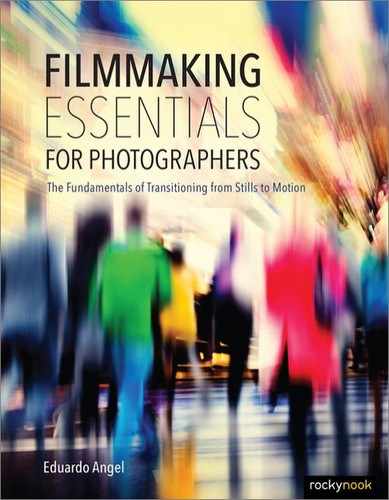CHAPTER 3
FILMMAKING STYLES
SCRIPT WRITING STYLES
According to Woody Allen, there are two kinds of film directors: “the ones who have it, and the ones who don’t.”
And I believe there are two kinds of film directors: the ones who write their own material, like Quentin Tarantino, and the ones who adapt existing material, like Alfred Hitchcock. Some directors fall in between—like the Coen Brothers, who have said, “We are willing to write for other people, but we would not direct a script that has been written by somebody else.”
John Boorman believes that “directing is really about writing, and all serious directors write.” Martin Scorsese believes that “the script is the most important thing, but it is not everything. What matters is the visual interpretation of what you have on paper.”
Scorsese also sees a significant difference between being a director and being a filmmaker. “The directors are people who only interpret the script, who just turn it from words into images. The filmmakers, however, will be able to take somebody else’s material and still manage to have a personal vision come through.”
Very few directors, like Wong Kar-Wai, do not work with scripts at all. “I write as a director, not as a writer, so I write with images. I start with a lot of ideas but the story is never clear. I know what I don’t want, but I don’t know what I want. The shooting process is the way for me to find all the answers. Sometimes I find them on the set, sometimes during the editing, sometimes three months after the first screening.”
DIRECTING STYLES
In terms of directing styles, there are some, like the Coen Brothers, who arrive to the set knowing exactly what they are going to shoot, how many cameras they need, and which lenses they’ll use. And there are others, like Woody Allen, who arrive every day with a concept and then follow their instincts to develop that concept into images.
Some directors, like David Fincher, spend a lot of time rehearsing each scene with the actors, shooting 30 takes of a single scene, and later figuring it all out in the editing room. Woody Allen believes that “it’s a grave error to think you can fix a weak script in the editing room.” Some directors, like Clint Eastwood, usually skip rehearsals and are known to prefer the actors’ first take.
Confused? Good. My point is that there isn’t a good way or a bad way to do most things in film. Some people prefer a rigid structure whereas others prefer flexibility. The only way to know what works best for you is to go shoot many different projects, with different people, and start finding your own style.
FRAME RATE
There are four main frame rates in the film industry: 24, 25, 30, and 60.
None of them will automatically give your footage a magical cinematic look, but 24 frames per second (technically speaking 23.976), also known as 24p, is being increasingly used for aesthetic reasons. Keep in mind that 24p can sometimes make your videos look worse, not better, because the frame rate is so slow that rapid movement can look jerky. I usually prefer to use a rate of 30 frames per second when I’m working on multimedia pieces or projects that will be distributed only online. And 60 frames per second is my go-to frame rate when I’m using gimbals or other camera movement tools.
Besides frame rate, other ways to emulate a cinematic look include shallow depth-of-field, camera movement, and appropriate lighting, among others.
SHUTTER SPEED
In photography, we are used to controlling proper exposure with three variables: shutter speed, ISO, and aperture (Figure 3.1). In video, both ISO and aperture remain as options, but we are much more limited with the shutter speed.
Figure 3.1 In still photography, exposure is determined by the shutter speed, aperture, and ISO settings.
As a rule of thumb, when you’re shooting video, set your shutter speed at twice your frame rate. So if you want to shoot at 24 frames per second, set your shutter speed at 1/48 or 1/50 second. Or if you’re shooting at 60 frames per second, set your shutter speed at 1/120 or 1/125 second. These are recommended starting points, not unbreakable universal laws.
Many cameras offer the option to shoot in slow motion. The shutter speed rule still applies, so at 96 frames per second you’ll need a shutter speed of 1/192 second, or approximately 1/200 second. Just like in photography, to achieve proper exposures when using fast shutter speeds, we need a lot of light, extremely wide apertures, high ISOs, or a proper balance of these elements.
SETUPS
Progress on a film set is usually measured in setups (Figure 3.2). A full-size feature film crew may shoot 10–30 setups per day, depending on lighting and location changes and the number of cameras. When Roger Deakins was working with the Coen Brothers, they used only one camera and averaged 11 setups per day. A TV show might achieve more setups if the lighting remains very consistent. For example, one season of House of Cards averaged 35 setups per day with 14 takes per setup. Another show, The Knick, averaged 28 setups per day. Depending on the scene, one setup translates to 2–6 minutes on screen. And days on a film set are long—12 hours is considered a normal workday.
Figure 3.2 A setup for a scene shot in a bedroom

HOMEWORK ASSIGNMENT
Shoot a still subject (for example, your printer or TV) using different frame rates while trying to maintain the same exposure. Then repeat the exercise, but this time shoot a moving subject (kids playing or traffic from a bridge). Compare the results. Which one looks more cinematic?


